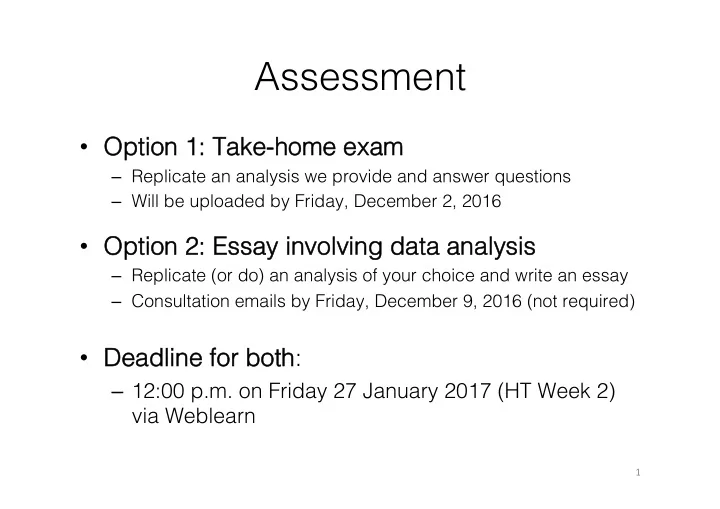

Assessment � • Option 1: Take-home exam Option 1: Take-home exam � – Replicate an analysis we provide and answer questions � – Will be uploaded by Friday, December 2, 2016 � • Option 2: Essay involving data analysis Option 2: Essay involving data analysis � – Replicate (or do) an analysis of your choice and write an essay � – Consultation emails by Friday, December 9, 2016 (not required) � • Deadline for both Deadline for both: � – 12:00 p.m. on Friday 27 January 2017 (HT Week 2) via Weblearn � 1
Drop-in sessions � • MT Week 8 MT Week 8 (Q-Step Lab): � • Tuesday, 10.00-12.00: Anna Petherick (Comp Gov) � • Wednesday, 10.00-12.00: Giacomo Arrighini (Pol Soc) � • Thursday, 10.00-12.00: Jeffrey Wright (IR) � • Friday, 10.00-12.00: Gerda Hooijer (Pol Soc) � • HT Week 1 HT Week 1 (Q-Step Lab): � • 15-min. slot bookings � • Alice E. will send you an email with a link to sign up � 2
Last week: influence � Outlier = big residuals. � • Problem = limited, but can increase standard error. � • Detect with studentized residuals. � High leverage = usually big or small value(s) of independent variable(s) � • Problem = can change coefficients � • Detect with hat values. � � Influence = Outlierness * Leverage � 3
If you find high-influence obs… � • Don’t pretend it doesn’t exist � • Investigate (think of Pat!) � • Check for a coding mistake � • Dummy out + compare � 4
Checking OLS: � Multicollinearity is the high correlation between two or more independent variables � • Problem: larger standard errors, unstable coefficients � • Detect: variance-inflation factor VIF � Heteroscedasticity � Uncorrelated error � Mean independence � (And) � What to check: � Normality � E � lineaRity � MulticollineaRity � O � R � 5
Interpretation of � Regression Results � Political Analysis 2, Lab 6 � (Just one more to go after this!) � anna.petherick@politics.ox.ac.uk � 6
Linearity Linearity � • whether X is really big or really tiny in value, its relationship with Y—its coefficient—is constant. � • “The predicted change in Y for a one-unit increase in X holding the other variables in the model constant. ” � 7
For example… � Predicting an incumbent party’s vote share in U.S. elections, using model C: � = 48.24 + (0.57*Growth) + (0.67*Good News) � • Growth is “previous year’s economic growth rate” (%) � • Good news is headlines – ‘no. of consecutive quarters of growth’. � Kellstedt and Whitten, p203 � 8
Interpreting coefficients • Statistical significance : p-value • Substantive significance : effect size • Independent variables are measured in their own units – Age (in years) – Gender (1=female, 0=male) – Income (in thousands $) à Calculate along the range (min-max) of X à Standardized coefficients (see homework section) 9 6
Think sensibly Think sensibly � • Always think substantively. � • Sometimes predictions are logically impossible or irrelevant. � 10 Credit: Catherine de Vries �
(non)-Linearity (non)-Linearity � 11
Transformations of X Transformations of X � • In OLS, the coefficients of the independent variables are not squared, cubed, square- rooted or logged. � • But non-linear relationships between X and Y can still be modelled by transforming X. � • For example, you could have something like: � Y= B 0 + B 1 *X + B 2 *X 2 + B 3 *log e Z � 12
Transformations of X cont… Transformations of X cont… � • Examples from the literature: district magnitude is often logged; so is area and GDP per capita… age is often squared. � • Predictions using logged or squared variables are generated as before, just remember to transform your value of X before multiplying by the Brazil’s 5,570 municipalities: � coefficient. - Altamira = 159 696 km ²� - Santa Cruz de Minas = 2.8 km ²� 13
Exponential exp(X)=e x Risk War Geographic Proximity Note: number e = 2:718281. 14
logarithmic Democracy GDP log(Y ) is defined as the power that you would need to raise e to in order to end up with Y ; i.e., e log(Y ) = Y . For example, log(7) = 1.945910149 15 because e 1.945910149 = 7.
Stretching and compressing data � To make these data linear.. � Either stretch out values of X: � Or compress values of Y: � 16
Over to you… � ? 17
When to transform X When to transform X � • Plot X against Y. � • Apply the 'bulging rule’: � X 2 X Tukey and Mosteller 18
When to transform X cont… When to transform X cont… � • Look for patterns in the residuals. � Hmm…that’s hardly a random distribution around zero! � Credit: statwing.com � 19
Fails and Krieckhaus (2010) 20
Recommend
More recommend